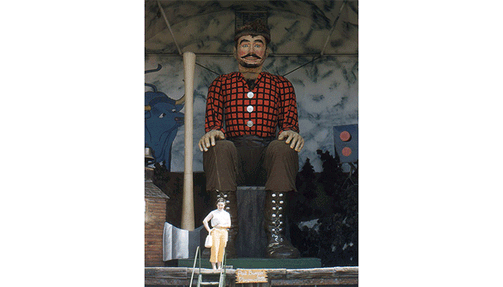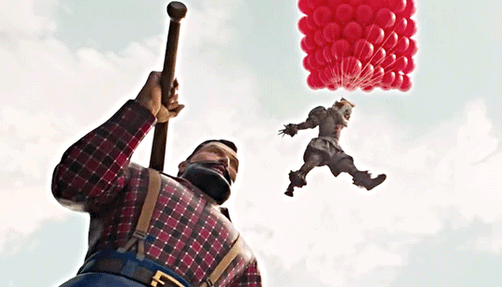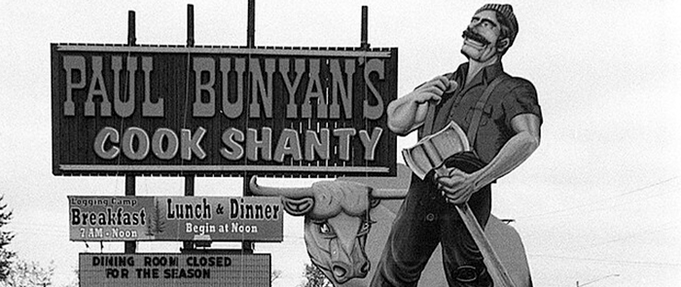Even today, most Americans are familiar with Paul Bunyan. The kaiju-sized lumberjack is as integral a part of American folk tradition as characters such as Johnny Appleseed and Davy Crockett. Unlike those two figures, however, Paul Bunyan probably wasn’t ever a real person—no matter how exaggerated by subsequent tales.
Tall Tales and Fearsome Critters
Instead, Paul Bunyan is rooted in the oral traditions of North American logging camps. During the late 1800s and early 20th century, logging was a significant business, carried out by dedicated lumberjacks who lived and worked together in logging camps, often isolated from the rest of the world by miles of wilderness.
These camps developed their own unique oral traditions, including their own folklore. These stories often featured various “fearsome critters” such as the hoop-snake, the fur-bearing trout, the goofus bird, the hidebehind, and the squonk, to name just a few. They also included tall tales about loggers of heroic stature, who were capable of suitably impressive deeds. Among these, none was more famous than Paul Bunyan.
“All lumberjacks believe, or pretend to believe, that he really lived and was the pioneer in the lumber country,” wrote Charles E. Brown, in his 1922 collection of Bunyan tales taken directly from Wisconsin loggers. “Some of the older men even claim to have known him or been members of his crew. In Wisconsin, the location of one of his camps is stated to have been 45 miles west of Rhinelander. Bunyan was a powerful giant, 7 feet tall with a stride of 7 feet. He was famous throughout the lumbering districts for his great physical strength. So great was his lung capacity that he called his men to dinner by blowing through a hollow tree; when he spoke, limbs sometimes fell from trees.”
An Advertising Giant
Of course, while elements of it are familiar, that depiction of a 7-foot-tall Paul Bunyan doesn’t exactly square with the literal giant most of us know today. So, how did the Paul Bunyan of logging camp stories transform into the giant we all know? The answer is advertising.
Among the earliest Paul Bunyan stories to reach an audience outside logging camps were those in the form of promotional brochures for the Red River Lumber Company, beginning in 1916. Written by William B. Laughead, these popular brochures expanded and embellished earlier oral stories of Paul Bunyan, including giving his famous blue ox the name “Babe” for the first time, and increasing Bunyan’s stature to something far beyond human. While the folkloric Bunyan had been a giant among men, Laughead’s towered over the trees themselves.
At the same time, Laughead (and other subsequent promoters) made use of the larger-than-life nature of the early Paul Bunyan stories, repurposing common motifs, such as a stovetop so big that it was greased by skating across it with hams strapped to one's feet. After all, such exaggerations were already commonplace in lumberjack tall tales, as can be seen in an account, published in The Stars and Stripes in 1919, of a winter so cold that “words froze right in the air.”

Statue of Paul Bunyan in 1956.
Photo Credit: Gary Hoover / Wikimedia CommonsA Not-So-Real American Hero
By the time the stories of Paul Bunyan as a giant striding across the forested vastness of the western United States were beginning to expand beyond the lumber camps and reach common readers all over the country, the days of the lumber camps were, themselves, numbered.
With America’s once trackless timberlands decimated by deforestation, new advances in logging technology, and logging itself no longer the moneymaking enterprise it once was, the lives of lumberjacks were changing—and, with them, the tall tales and oral traditions that had defined life in the lumber camps. Yet, America wasn’t done with Paul Bunyan.
“When tourism began to replace logging as the foundation of the Northwoods economy in the 1920s, Paul Bunyan became the symbol of an idealized past,” writes the Wisconsin Historical Society. Already, Bunyan was associated with the creation of several landmarks, with Laughead writing that Paul and Babe created the many lakes of Minnesota with their footprints. Subsequent promoters, tourist agents, and yarn-spinners attributed many other landmarks to his exploits, ranging from the Grand Canyon and the Missouri River to Oregon’s Mount Hood, which was formed when Bunyan piled rocks on his campfire to put it out.
Nor were these the only ways in which Bunyan’s exploits were put to capitalist or propaganda ends. As stated by the Wisconsin Historical Society, “In the 1930s he was used as an icon of the heroic proletarian worker, and in the 1940s he was enlisted to fight the Nazis. His name and face appeared on uncounted restaurant menus and tourist attractions across the country, and were used to advertise everything from construction lumber to loaves of bread.” Not bad for a guy who got his start in stories told to pass the time in logging camps.
Paul Bunyan Today
As the folkloric figure of Paul Bunyan became an advertising icon, he gradually moved away from his original place in lumberjack tradition and settled into a realm usually reserved for children’s books and movies—he has appeared in hundreds.
While Paul Bunyan may not be as popular today as he once was, his legacy remains. Statues of the lumberjack and his big blue ox can be found throughout the northern United States—a fictional one also makes a memorable appearance in the 2019 film It Chapter 2.

Paul Bunyon in It Chapter 2.
Photo Credit: Warner Bros. PicturesFor the more internet-savvy amongst us, our most frequent encounter with Paul Bunyan might be one of many memes questioning whether or not he is a kaiju. (The answer, at least according to translator Zack Davisson, who explores the term “kaiju” in his book The Ultimate Guide to Japanese Yokai, is no. Kaiju means “strange beast.” For giant-sized humans, the more appropriate term is “kaijin.”)
Whether a tall tale or advertising ploy, a tourist attraction or a kaijin, Paul Bunyan is one thing that is pretty inescapable: a uniquely American figure, and part of a rich oral and written history.
Featured image: Tom Hart / Wikimedia Commons
